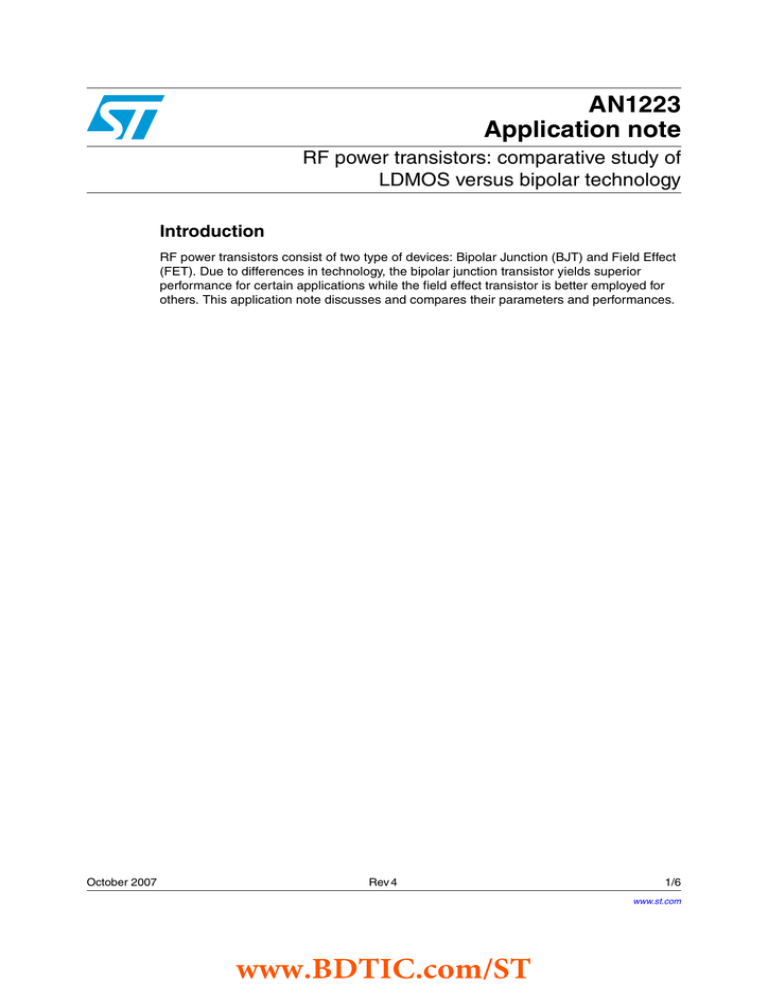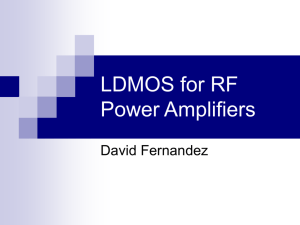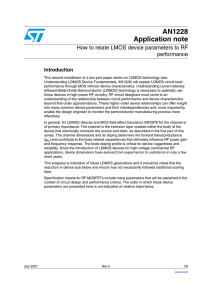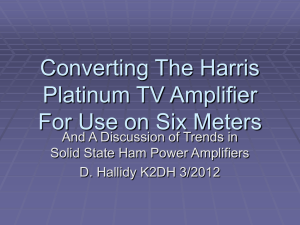
AN1223
Application note
RF power transistors: comparative study of
LDMOS versus bipolar technology
Introduction
RF power transistors consist of two type of devices: Bipolar Junction (BJT) and Field Effect
(FET). Due to differences in technology, the bipolar junction transistor yields superior
performance for certain applications while the field effect transistor is better employed for
others. This application note discusses and compares their parameters and performances.
October 2007
Rev 4
1/6
www.st.com
www.BDTIC.com/ST
LDMOS advantages
1
AN1223
LDMOS advantages
LDMOS (and MOSFETs in general) have superior characteristics on the following points:
1.
Thermal stability
2.
Frequency stability
3.
Higher gain
4.
Increased ruggedness
5.
Lower noise
6.
Lower feedback capacitance
7.
Simpler bias circuitry
8.
Constant input impedance
9.
Better IMD performances
10. Lower Thermal Resistance
11. Better AGC Capability
1.1
Thermal stability
LDMOS, unlike bipolars, have a negative temperature coefficient and therefore are
protected against thermal runaway. This is illustrated as follows: as the device draws more
current, its temperature rises. A rise in temperature causes an increase in the gate threshold
voltage (VGth) which turns the device off resulting in a drop in current.
Bipolars, on the other hand, have a positive temperature coefficient and are prone to
thermal runaway. The main reason for this is the increase of hFE due to the increase of
temperature. As the device draws more current its temperature rises, hence hFE rises and
even more current is drawn resulting in a further temperature hike. This goes on until the
device fails. Hence, bipolars need elaborate temperature compensation to prevent such
occurrence. MOSFETs, however, are protected against thermal runaway and no
compensation is required.
1.2
Frequency stability
Lack of diode junctions and a higher ratio of feedback capacitance versus input impedance
make LDMOS more stable than bipolars. Moreover, bipolars suffer an instability mode
known as half f0 due to the varactor effect in base-emitter junction and a lower ratio of
feedback capacitance versus input impedance.
1.3
Higher gain
Two factors contribute to LDMOS superior gain characteristics compared to an equivalent
bipolar (see Figure 1). First, wire-bonded connections, which normally connect the source
and the external circuitry (because of the vertical bipolar structure - collector on the bottom),
are no longer required. The negative feedback due to the wires’ self-capacitance and
inductance is greatly reduced. This leads to higher gain at high frequencies. Second, in a
bipolar, thermal stability is achieved at the detriment of gain. In an attempt to lessen the
likelihood of bipolar thermal runaway, ballast resistors are placed in the emitters of the
2/6
www.BDTIC.com/ST
AN1223
LDMOS advantages
device. This helps to prevent current hogging. Current hogging occurs when one of the
many emitters within the transistor die draws more current than the others. As a single
emitter draws more current, its temperature hikes and hFE increases, leading to a thermal
runaway situation. Placing resistors in the emitters of a device helps to share the current
more equally, therefore decreasing the likelihood of thermal runaway. However, gain pays
the price for this increased thermal stability. Consequently, in a bipolar the gain is lesser
than that in an LDMOS. The fact that an LDMOS has a higher gain means that less
amplifying stages are needed, which in turn, means higher reliability and lower costs.
Figure 1.
1.4
Gain vs. output power
Increased ruggedness
In an LDMOS, the source and channel are shorted, hence there is no more breakdown
voltage (BVCEO).
Consequently, device ruggedness is significantly improved. MOSFETs are indeed more
rugged than their bipolar counterpart. Ruggedness is an important factor for applications
such as commercial radios where the output devices are generally not protected by an
isolator (circulator) and often experience large load mismatches.
1.5
Lower noise
Another drawback of ballast emitter resistors in bipolars is increased noise since current
flowing through these resistors generates noise. MOSFETs are unaffected since they are
not fitted with ballast resistors. For most amplifiers this is unimportant but for applications,
such as transceivers, which have a transmitter biased for linear operation and a receiver
located nearby, noise is a critical factor.
1.6
Lower feedback capacitance
Many broadband amplifiers use negative feedback to achieve good gain flatness across a
wide frequency range. These applications request low feedback capacitance (the one
3/6
www.BDTIC.com/ST
LDMOS advantages
AN1223
between the output lead and the input lead of a device). MOSFET feedback capacitance
(LDMOS) is typically 5 times lower than the feedback capacitance of a comparable bipolar.
1.7
Simpler bias circuitry
MOSFETs are voltage controlled devices, therefore no current is drawn from the bias
circuitry.
Furthermore, MOSFETs have a negative temperature coefficient, hence no temperature
compensating component in the bias circuitry is required. Consequently, the bias circuit
remains very simple and biasing can be done with a plain voltage divider.
1.8
Constant input impedance
MOSFETs input impedance varies only slightly with gate voltage fluctuation. This makes it
very suitable for amplitude modulation applications where a constant load on the driver
stage is necessary in order to prevent parasitic amplitude modulation. Also, MOSFETs
constant gate impedance permits identical input matching network for any class of operation
(class A, AB, B or class C).
Figure 2.
1.9
Third order intermodulation distortion vs. output power
Better IMD performances
As stated above, MOSFETs’ constant input impedance, as a function of input power level,
allows better Intermodulation Distortion (IMD) performances at low power levels (see
Figure 2). Bipolars’ input impedance varies with input power level, hence the transistor
becomes unmatched from its matching network and so generates a higher level of IMD.
1.10
Lower thermal resistance
Since the LDMOS have a lower power density (LDMOS’ dice are larger than bipolars’),
dissipated heat occurs through a larger area. Moreover, LDMOS do not require an electrical
isolator (BeO). Consequently, LDMOS thermal resistance is considerably better than a
comparable bipolar.
4/6
www.BDTIC.com/ST
AN1223
1.11
LDMOS main drawbacks
Better AGC capability
The relationship between the drain current (Id) and the gate voltage (Vg) makes LDMOS
(MOSFET) ideal for Automatic Gain Control (AGC) applications. This relationship is linear
almost from turn-on to saturation. This means that LDMOS gain can be controlled
throughout a wider range of power levels. Typically LDMOS have 30 dB AGC range or
better, while AGC range of a comparable bipolar is around 15 dB.
2
2.1
LDMOS main drawbacks
1.
Lower power density
2.
Damage due to electrostatic discharge
Lower power density
For a comparable power level more die area is required by an LDMOS than a bipolar. This
results in less dice per wafer and therefore higher MOSFET (LDMOS) cost. A larger area
also restricts maximum available power for a given package.
2.2
Damage due to electrostatic discharge
Electrostatic discharge, which can reach up to several hundreds of volts, can deteriorate the
gate to source channel of the LDMOS so anti-static protection handling is mandatory.
3
Conclusion
LDMOS products are best suited for applications such as CDMA, W-CDMA, TETRA, Digital
Terrestrial TV etc., requiring wide frequency range, high linearity and good ruggedness
performances. But above all, LDMOS are flawless for a high linearity requisite. They can be
used in class AB (by reducing the output power until the desired linearity is achieved),
where a comparable bipolar could only attain the same linearity in class A, occasioning a
high current consumption.
4
Revision history
Table 1.
Document revision history
Date
Revision
Changes
21-Jun-2004
3
Minor text changes
04-Oct-2007
4
No content changes, document reformatted
5/6
www.BDTIC.com/ST
AN1223
Please Read Carefully:
Information in this document is provided solely in connection with ST products. STMicroelectronics NV and its subsidiaries (“ST”) reserve the
right to make changes, corrections, modifications or improvements, to this document, and the products and services described herein at any
time, without notice.
All ST products are sold pursuant to ST’s terms and conditions of sale.
Purchasers are solely responsible for the choice, selection and use of the ST products and services described herein, and ST assumes no
liability whatsoever relating to the choice, selection or use of the ST products and services described herein.
No license, express or implied, by estoppel or otherwise, to any intellectual property rights is granted under this document. If any part of this
document refers to any third party products or services it shall not be deemed a license grant by ST for the use of such third party products
or services, or any intellectual property contained therein or considered as a warranty covering the use in any manner whatsoever of such
third party products or services or any intellectual property contained therein.
UNLESS OTHERWISE SET FORTH IN ST’S TERMS AND CONDITIONS OF SALE ST DISCLAIMS ANY EXPRESS OR IMPLIED
WARRANTY WITH RESPECT TO THE USE AND/OR SALE OF ST PRODUCTS INCLUDING WITHOUT LIMITATION IMPLIED
WARRANTIES OF MERCHANTABILITY, FITNESS FOR A PARTICULAR PURPOSE (AND THEIR EQUIVALENTS UNDER THE LAWS
OF ANY JURISDICTION), OR INFRINGEMENT OF ANY PATENT, COPYRIGHT OR OTHER INTELLECTUAL PROPERTY RIGHT.
UNLESS EXPRESSLY APPROVED IN WRITING BY AN AUTHORIZED ST REPRESENTATIVE, ST PRODUCTS ARE NOT
RECOMMENDED, AUTHORIZED OR WARRANTED FOR USE IN MILITARY, AIR CRAFT, SPACE, LIFE SAVING, OR LIFE SUSTAINING
APPLICATIONS, NOR IN PRODUCTS OR SYSTEMS WHERE FAILURE OR MALFUNCTION MAY RESULT IN PERSONAL INJURY,
DEATH, OR SEVERE PROPERTY OR ENVIRONMENTAL DAMAGE. ST PRODUCTS WHICH ARE NOT SPECIFIED AS "AUTOMOTIVE
GRADE" MAY ONLY BE USED IN AUTOMOTIVE APPLICATIONS AT USER’S OWN RISK.
Resale of ST products with provisions different from the statements and/or technical features set forth in this document shall immediately void
any warranty granted by ST for the ST product or service described herein and shall not create or extend in any manner whatsoever, any
liability of ST.
ST and the ST logo are trademarks or registered trademarks of ST in various countries.
Information in this document supersedes and replaces all information previously supplied.
The ST logo is a registered trademark of STMicroelectronics. All other names are the property of their respective owners.
© 2007 STMicroelectronics - All rights reserved
STMicroelectronics group of companies
Australia - Belgium - Brazil - Canada - China - Czech Republic - Finland - France - Germany - Hong Kong - India - Israel - Italy - Japan Malaysia - Malta - Morocco - Singapore - Spain - Sweden - Switzerland - United Kingdom - United States of America
www.st.com
6/6
www.BDTIC.com/ST







